The Jurassic flora of North Yorkshire
Click on the photos to enlarge them and to get more information
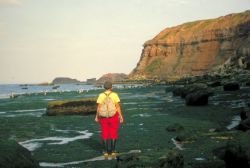 The
beautiful cliff coast of Yorkshire is well-known to many collectors because
of the fine fossils from the Jurassic and the Cretaceous which can be found
here. These include ammonites, bivalves and remains of reptiles. However,
important finds of Jurassic plant remains are also made in this area. On
the one hand there is a large variation of plants found there, on the other
hand a great deal of the plants have their cuticle (the waxy wrapping
layer) preserved which gives a detailed picture of the cell structures. The
fossils, however, are generally not very spectacular: they are not museum
pieces (with exceptions). An exhibition will not attract crowds of people. The
beautiful cliff coast of Yorkshire is well-known to many collectors because
of the fine fossils from the Jurassic and the Cretaceous which can be found
here. These include ammonites, bivalves and remains of reptiles. However,
important finds of Jurassic plant remains are also made in this area. On
the one hand there is a large variation of plants found there, on the other
hand a great deal of the plants have their cuticle (the waxy wrapping
layer) preserved which gives a detailed picture of the cell structures. The
fossils, however, are generally not very spectacular: they are not museum
pieces (with exceptions). An exhibition will not attract crowds of people.
A bit of geology
Following the impressive cliff path along the North Yorkshire coast
from Middlesborough via Whitby to Bridlington, the layers are getting younger
and younger, with some local exceptions. Roughly spoken the layers go through
the time scale from the Lower Jurassic to the Upper Cretaceous. In most cases
the depositions are marine, but there are also a couple of terrestrial sediments,
or better deltaic sediments. And that's where the plant fossils occur.
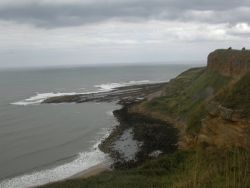 These
strata date from the Middle Jurassic and they have been formed by rivers
flowing in eastern direction. These brought in so much silt and sand, that
deltas came into existence. From time to time creeks got blocked and many
plant remains got embedded in the mud. Because of the fact that the complete
area was lowering slowly, this proces could continue during a long time,
but from time to time the delta was inundated and got covered with a layer
of sand. Thus it could happen that some of the blocked creeks petrified totally,
plant remains included. In the open river arms and in the estuaries also
plants were deposited, but these were so heavily damaged that only chopped
plants have remained. These
strata date from the Middle Jurassic and they have been formed by rivers
flowing in eastern direction. These brought in so much silt and sand, that
deltas came into existence. From time to time creeks got blocked and many
plant remains got embedded in the mud. Because of the fact that the complete
area was lowering slowly, this proces could continue during a long time,
but from time to time the delta was inundated and got covered with a layer
of sand. Thus it could happen that some of the blocked creeks petrified totally,
plant remains included. In the open river arms and in the estuaries also
plants were deposited, but these were so heavily damaged that only chopped
plants have remained.
The three depositions with plant fossils are (from old to younger):
the Saltwick Formation, the Gristhorpe Member and the Scalby Formation. The
Gristhorpe Member is part of the Cloughton Formation. See scheme. The layers
alternate with marine depositions. And just fossils from these marine layers
are used for dating. This is not possible with the fossils from the delta
depositions.
Look for more extensive information on the geology of the area in the
booklet of Van Konijnenburg-van Cittert &
Morgans (1999).
| Scalby Formation (delta) with the Scalby Plant Bed |
| Scarborough Formation (marine) |
| Cloughton Formation |
Gristhorpe Member (delta) with the Gristhorpe Plant Bed |
| Lebberston Member (marine) |
| Sycarham Member (marine) |
| Ellerbeck Formation (marine) |
| Saltwick Formation (delta) with the Whitby Plant Bed |
Sites
We (my wife and I) have collected mainly at four places: Whitby (with
the Whitby Plant Bed), Hayburn Wyke (also with the Whitby Plant Bed but with
different content and age), Scalby (Scalby Plant Bed) and Cayton Bay (Gristhorpe
Plant Bed). We have also found nice fossils on the beach between these places,
e.g. near Burniston, but in the first mentioned places the fossils are still
in the layer and not rolled.
For the exact location of the sites I refer again to Van Konijnburg-van
Cittert & Morgans (1999) in which booklet a precise description is given
how to find the places. Recently the sites have been placed under protection:
they are now Sites of Special Scientific Interest (SSSI). Permission of the
owner is required, but as far as I understand modest collecting of fossils
is still possible. In the booklet another place has been mentioned, i.e.
Hasty Bank, inland. For entering of this site permission of the Head Forester
is required. We didn't visit this place.
Generally it can be said that a portion of perseverence and motivation
is needed to find the right place and to bring the fossils home. The access
roads are often long and (especially at rainy times) passible with difficulty.
On the beach in many cases one must walk and climb over the boulders and
the way back is (when you are lucky) even more difficult.
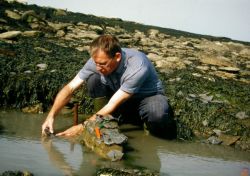 The
rock with the fossils is often hard clay, sometimes sandstone and by exception
ironstone. It is necessary (except at Hasty Bank, which is situated inland)
to collect at low tide. Thus the first thing to do is to buy a tides table. The
rock with the fossils is often hard clay, sometimes sandstone and by exception
ironstone. It is necessary (except at Hasty Bank, which is situated inland)
to collect at low tide. Thus the first thing to do is to buy a tides table.
The fossils are covered with a coaly layer, which is rather vulnerable.
If you use a hard brush the beauty will vanish. Let them dry and wipe them
off (if really necessary) with a very soft brush.
Five warnings:
1. Mind the tides. The upcoming water could surprise and enclose you.
2. Mind falling stones from the cliff. Don't walk under steep
cliffs.
3. Sometimes the cliffs are unstable: you could sink away in them when
the soil is soaked.
4. Be careful not to sprain your ankle while walking and climbing over
the boulders.
5. Don't go alone.
Cuticle
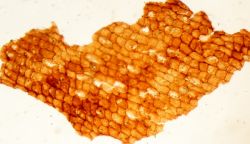 The fossil seed plants from Yorkshire
have preserved their cuticle. This is special because in many other sites
this is not the case. This waxy protection layer includes a print of the
cell structure of the epidermis and is very important for the scientists. The fossil seed plants from Yorkshire
have preserved their cuticle. This is special because in many other sites
this is not the case. This waxy protection layer includes a print of the
cell structure of the epidermis and is very important for the scientists.
The black layer on the fossils consists of coal and is enveloped by
the cuticle. With a special treatment including calcium chlorate and
nitric acid, called maceration, the coal can be dissolved. The cuticle remains
and can be used for making a microscopic slide. With these slides often species
can be identified with certainty. Some plants are resembling each other very
much, while the cuticles can be very different. On the left the cuticle of
the cycas Nilssonia compta.
The cuticles of the (real) ferns are hardly ever fossilized because
they were too thin.
The flora
In the impressive standard work of Harris the flora of North Yorkshire
is extensively described in five books. If possible the cuticles of the plants
are also depicted. The book parts came out respectively in 1961, 1964, 1969,
1974 and 1979.
In this chapter I don't try to be complete, but I give a report of the
species we have collected ourselves. With this it is yet possible to get
a nice picture of the flora during the Jurassic.
In the Jurassic the modern flowering plants were not yet evolved: they
took over in the Early Cretaceous. During the Jurassic the gymnosperms were
dominant, but the ferns were also abundant. The following groups can be
distinguished:
1. Horsetails 2. Ferns 3. Seed ferns 4. Bennetitales
(Cycas resembling plants with flowers (!))
5. Cycas-like plants 6. Ginkgo-like plants 7.
Czekanowskia-like plants (an extinct group of plants with needlelike
leaves) 8. Conifers.
The liverworts, which have been found here, I leave out of consideration.
Click on a picture to go to the plants of this
group.
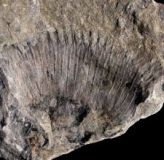
1. Horsetails |
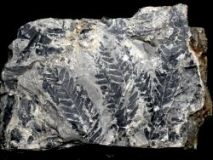
2. Ferns |
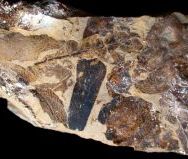
3. Seed ferns |
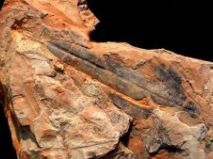
4. Bennettitales |
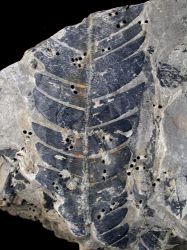
5. Cycas-like plants |
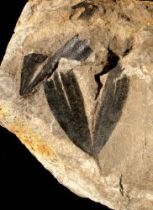
6. Ginkgo-like plants |

7. Czekanowskia-like plants |
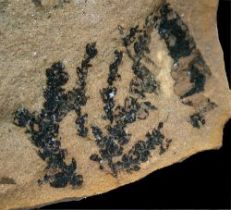
8. Conifers |
Conclusion
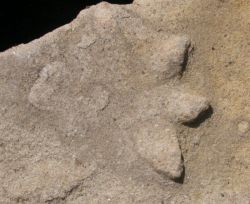 The
coastal area of North Yorkshire is one the most important sites for plants
from the Jurassic. The standard work of Harris proves that very convincing.
Isn't it exceptional that plants which were growing 150 million years ago,
show their cell structure and can be studied in detail? But a lot of effort
is needed to extract the fossils from the rock and good fortune is needed
to find rather complete specimens. The
coastal area of North Yorkshire is one the most important sites for plants
from the Jurassic. The standard work of Harris proves that very convincing.
Isn't it exceptional that plants which were growing 150 million years ago,
show their cell structure and can be studied in detail? But a lot of effort
is needed to extract the fossils from the rock and good fortune is needed
to find rather complete specimens.
It can be said that of many modern families, like ferns, horsetails, cycases
and conifers, relatives already grew in the Yorkshire delta.
The landscape is in one word: spectacular.
Near Burniston large footprints of dinosaurs occur. Excursions are organized
to the (protected) place where they are found. Ask the Tourist Information
about it. We only found one small footprint and we were childlike happy with
it.
Top
Literature
|